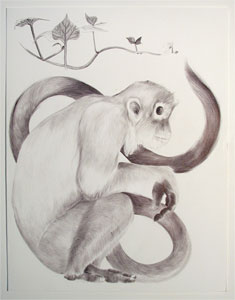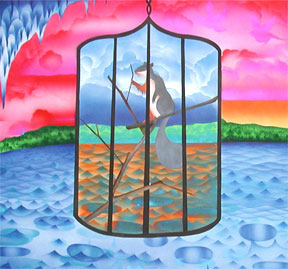This fall being an artist has been about sitting in my comfortable chair by the window drawing monkey fur. I started work on a series of drawings about monkeys recently and the way I'm drawing them is so labor intensive that by the time Thom gets home and asks what I've been doing I find that I can honestly say, "Oh, drawing monkey tail all day." I love the way these drawings are coming out, though. There are two of them in the show at Moti Hasson gallery and I've just posted one on my website.

My favorite monkey subjects are these truly beautiful monkeys called Langours. There's a lady langour at the Philadelphia zoo who is so gorgeous she makes people shut up when they see her. (This is unusual. People are loud at the zoo.) The sign on her cage says that she is the dominant female of her troop of monkeys and explains that Langours are not lazy, that they digest their food by lying together in a heap. Which is what they are usually doing. Langours have a compellingly human quality that makes them fascinating to watch. They are gentle with each other, and they react to being stared at in a way that seems personal. Langours seem to be keeping their dignity intact.
I'm going to try to finish up another monkey drawing today, and then tomorrow I'm going to start a huge piece I'm making for the Philadelphia Airport's exhibition program. It's going to be 48 feet long. I'm making it in 12' sections that will be joined together to make one long narrative in Terminal F. The piece will be hung in a long corridor, and I'm going to try to incorporate a narrative structure that flows over the length of the piece so that people get a sense of plot as they walk along the concourse beside the painting. The trick is going to be trying to make it work from each end.
(Groups of monkeys are called troops, it turns out, or cartloads. Which is confusing. Could I say that there is a cartload of langours in a tree? At least I'm not talking about apes, though. A group of apes is called a shrewdness. Look at this list if you really want to explore the oddness of the way English language speakers experience the natural world.

No comments:
Post a Comment